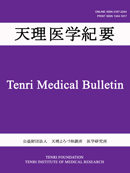Volume 20, Issue 2
Displaying 1-8 of 8 articles from this issue
- |<
- <
- 1
- >
- >|
Original Article
-
Article type: Original Article
2017 Volume 20 Issue 2 Pages 80-87
Published: December 25, 2017
Released on J-STAGE: December 25, 2017
Download PDF (889K) -
Article type: Original Article
2017 Volume 20 Issue 2 Pages 88-96
Published: December 25, 2017
Released on J-STAGE: December 25, 2017
Download PDF (897K)
-
Article type: 2016 Symposium Organized by Tenri Institute of Medical Research
2017 Volume 20 Issue 2 Pages 98-105
Published: December 25, 2017
Released on J-STAGE: December 25, 2017
Download PDF (3675K) -
Article type: 2016 Symposium Organized by Tenri Institute of Medical Research
2017 Volume 20 Issue 2 Pages 106
Published: December 25, 2017
Released on J-STAGE: December 25, 2017
Download PDF (272K) -
Article type: 2016 Symposium Organized by Tenri Institute of Medical Research
2017 Volume 20 Issue 2 Pages 107-113
Published: December 25, 2017
Released on J-STAGE: December 25, 2017
Download PDF (1210K) -
Article type: 2016 Symposium Organized by Tenri Institute of Medical Research
2017 Volume 20 Issue 2 Pages 114
Published: December 25, 2017
Released on J-STAGE: December 25, 2017
Download PDF (247K)
Pictures at Bedside and Bench
-
Article type: Pictures at Bedside and Bench
2017 Volume 20 Issue 2 Pages 115-118
Published: December 25, 2017
Released on J-STAGE: December 25, 2017
Download PDF (1501K)
Meeting Report
-
Article type: Meeting Report
2017 Volume 20 Issue 2 Pages 119-121
Published: December 25, 2017
Released on J-STAGE: December 25, 2017
Download PDF (1209K)
- |<
- <
- 1
- >
- >|
